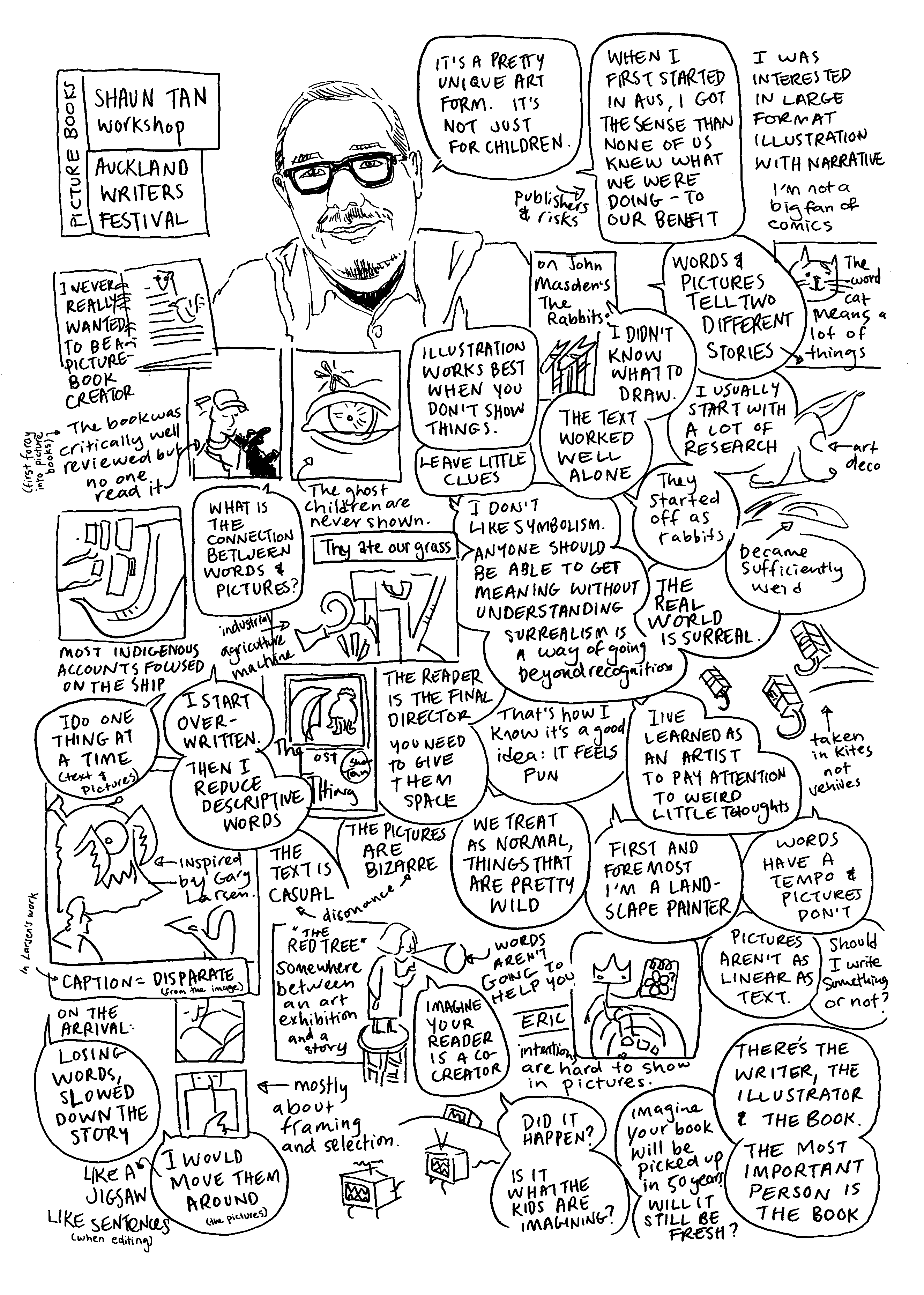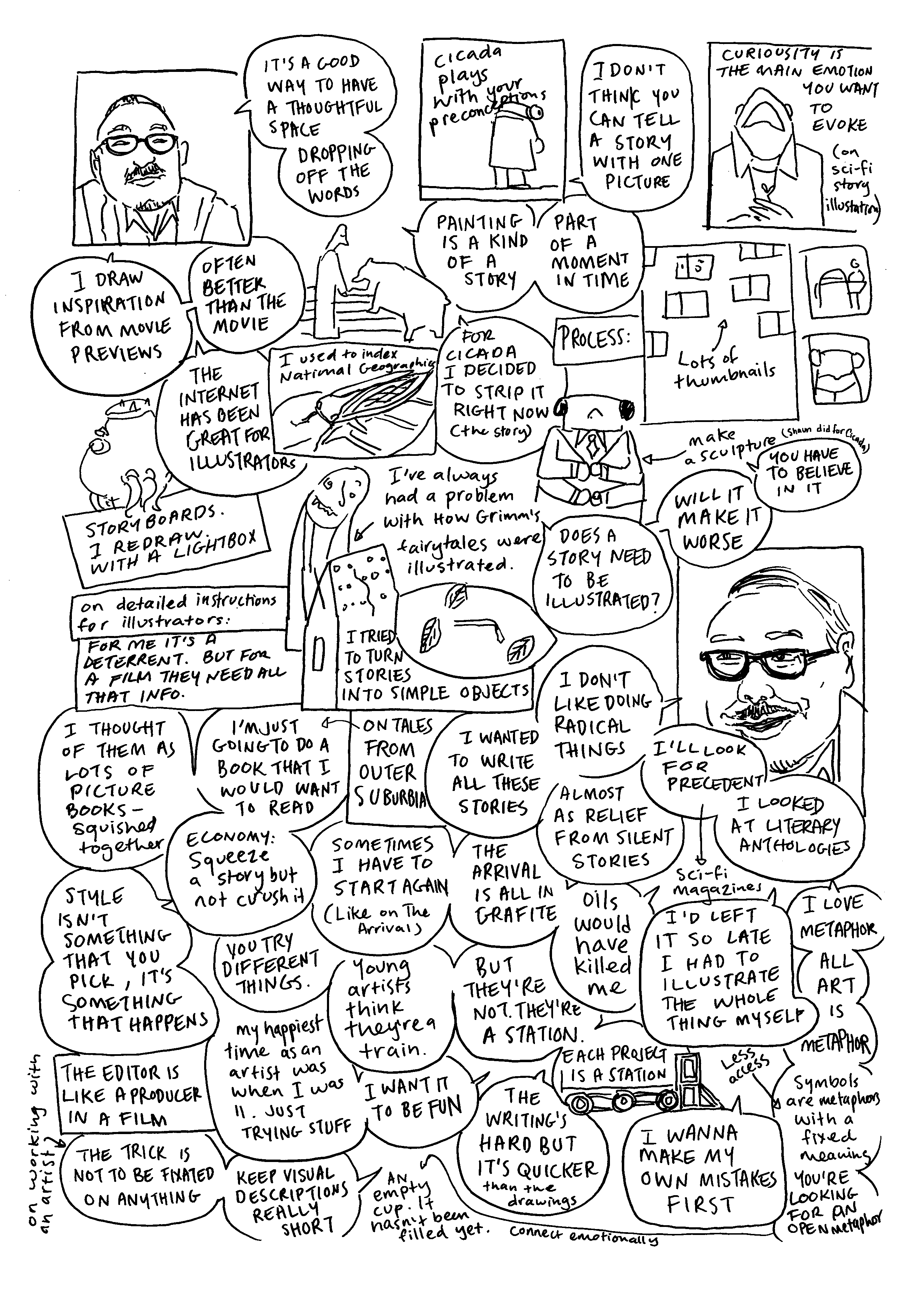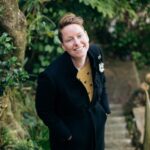Tara Black attended a masterclass at the Auckland Writer’s Festival on how to create a picture book with Shaun Tan—and she was kind enough to share her discoveries with us in her super special comic reportage style! If you can’t read the images, you’ll find the text below the comic itself—but read on for Tara’s take on Tan.


Shaun Tan masterclass
Narrated as it makes sense, mainly left-right, but sometimes reading down in the voice bubbles. Each voice bubble is a paragraph. Shaun is illustrated wearing dark-rimmed glasses and with a small moustache, with short dark hair.
[page 1][Image of Shaun Tan] It’s a pretty unique art form. It’s not just for children.
On publishers & risks: When I first started in Aus, I got the sense that none of us knew what we were doing – to our benefit.
I was interested in large format illustration with narrative. I’m not a big fan of comics.
I never really wanted to be a picture book creator [on pages of a book, with lines on the right-hand side]
On first foray into picture books: The book was critically well reviewed but no one read it. [comic with person and dark figure] What is the connection between words and pictures. [image of eye with insect] The ghost children are never shown.
On John Marden’s The Rabbits: I didn’t know what to draw. The text worked well alone. [Image two stylised rabbits]. I usually start with a lot of research [art deco image]. They started off as rabbits, and became sufficiently weird.
[image of squares and a curved koru-shape] Most indigenous accounts focused on the ship.
They ate our grass. [image of an industrial agriculture machine]
Illustration works best when you don’t show things.
Leave little clues.
I don’t like symbolism. Anyone should be able to get meaning without understanding. Surrealism is a way of going beyond recognition. The real world is surreal.
I start over-written. Then I reduce descriptive words. I do one thing at a time (text, and pictures). [image of The Lost Thing cover] The reader is the final director. You need to give them space.
We treat as normal, things that are pretty wild. That’s how I know it’s a good idea: it feels fun.
I’ve learned as an artist to pay attention to weird little thoughts. [background image of kites] connected text – taken in kites not vehicles.
[image of Gary Larsen cartoon with a monster that looks like the lost thing. Connected text: Inspired by Gary Larsen] In Larsen’s work – Caption = disparate (from the image) .
The text is casual, the pictures are bizarre. There is a dissonance between the two.
First and foremost I’m a landscape painter. Words have a tempo and pictures don’t.
The Red Tree – is somewhere between and art exhibition and a story. [image of person on a stool with a loudspeaker] Imagine your reader is a co-creator. From loudspeaker: words aren’t going to help you.
Eric [image of eric who is a little man with a crown head, holding up a flower picture with a question mark] intentions are hard to show in pictures.
Pictures aren’t as linear as text. Should I write something or not?
On The Arrival [two squares with a person looking at a book in different ways]
Losing words, slowed down the story. I would move them around (the pictures). Like a jigsaw like sentences (when editing). It was mostly about framing and selection.
[picture of three TVs walking across a hill] Did it happen? Is it what the kids are imagining?
Imagine your book will be picked up in 50 years. Will it still be fresh?
There’s the writer, the illustrator, and the book. The most important person is the book.
[page 2]
[boxed image of Shaun] I draw inspiration from movie previews, which are often better than the movie. The internet has been great for illustrators. I used to index National Geographic.
It’s a good way to have a thoughtful space, dropping off the words.
[image of cicada with trenchcoat in a box] words: cicada plays with your preconceptions.
I don’t think you can tell a story with one picture.
Painting is a kind of a story, part of a moment in time.
For cicada I decided to strip it right now (the story)
Process: [image with box, lots of thumbnails] [two smaller boxed images with minimal detail]
[boxed image of cicada with mouth open] and words: curiousity is the main emotion you want to evoke (on sci-fi story illustration)
Storyboards. I redraw with a lightbox [image of the lost thing].
[image of a giant] I’ve always had a problem with how Grimm’s fairytales were illustrated. [image of a building with a crack in the roof with tiles] I tried to turn stories into simple objects [image of face made out of leaves and a twig.]
Does a story need to be illustrated? Will it make it worse?
[image of cicada wearing a suit with a die] make a sculpture (Shaun did for Cicada). You have to believe in it.
On detailed instructions for illustrators: for me it’s a deterrant. But for a film they need all that info.
On Tales from Outer Suburbia. I wanted to write all these stories, almost as relief from silent stories. [image of Shaun talking] I don’t like doing radical things. I’ll look for precedent. I looked at literary anthologies, sci-fi magazines.
I thought of them as lots of picture books – squished together. I’m just going to do a book that I would want to read. Economy: squeeze a story, but not crush it.
I’d left it so late I had to illustrate the whole thing myself. (a sci-fi mag)
Style isn’t something that you pick, it’s something that happens. You try different things. Sometimes I have to start again (like on The Arrival). The Arrival is all in graphite, oils would have killed me.
Young artists think they’re a train. But they’re not. They’re a station. Each project is a station. [image of a train]
The editor is like a producer in a film.
My happiest time as an artist was when I was 11. Just trying stuff. I want it to be fun.
The writing’s hard, but it’s quicker than the drawings.
I wanna make my own mistakes first.
I love metaphor. All art is metaphor. Symbols are metaphors with a fixed meaning. You’re looking for an open metaphor, to connect emotionally. An empty cup. It hasn’t been filled yet.
On working with an artist: the trick is not to be fixated on anything. Keep visual descriptions really short.

Tara Black
Tara Black can often be found in the front row of book events, illustrating authors and their ideas. She has an MCW from Massey University and loves fried potato. Her first graphic novel, This Is Not a Pipe, is out now from VUP. Image: Ebony Lamb



